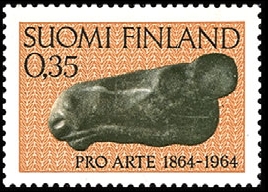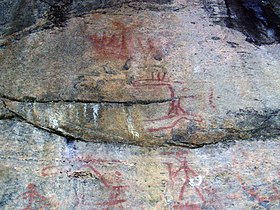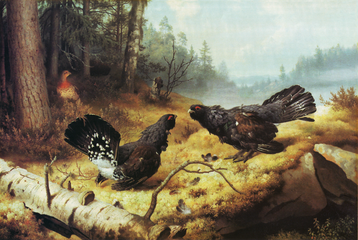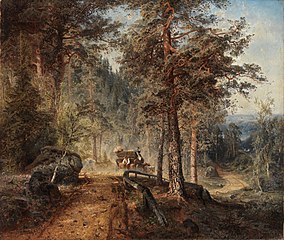
Akseli Gallen-Kallela was a Finnish painter who is best known for his illustrations of the Kalevala, the Finnish national epic. His work is considered a very important aspect of the Finnish national identity. He changed his name from Gallén to Gallen-Kallela in 1907.
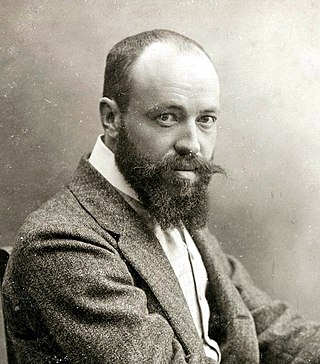
Hugo Gerhard Simberg was a Finnish symbolist painter and graphic artist.

Carl Ludvig Engel, or Johann Carl Ludwig Engel, was a German architect whose most noted work can be found in Helsinki, which he helped rebuild. His works include most of the buildings around the capital's monumental centre, the Senate Square and the buildings surrounding it. The buildings are Helsinki Cathedral, The Senate, the Helsinki City Hall, and the library and the main building of Helsinki University.

Ateneum is an art museum in Helsinki, Finland and one of the three museums forming the Finnish National Gallery. It is located in the centre of Helsinki on the south side of Rautatientori square close to Helsinki Central railway station. It has the biggest collections of classical art in Finland. Before 1991 the Ateneum building also housed the Finnish Academy of Fine Arts and University of Art and Design Helsinki.
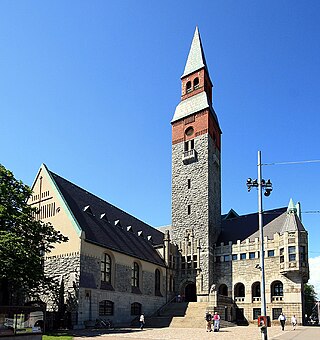
The National Museum of Finland is a museum in Helsinki presenting Finnish history from the Stone Age to the present day, through objects and cultural history. The Finnish National Romantic style building is located at Mannerheimintie 34 in central Helsinki and is a part of the Finnish Heritage Agency, under the Ministry of Culture and Education.

Finnish National Gallery is the largest art museum institution of Finland. It consists of the Ateneum, an art museum; Kiasma, a contemporary art museum; and the Sinebrychoff Art Museum, a historic house and art museum.

Vartiovuori Observatory is a former observatory in Turku, Finland. The observatory, designed by Carl Ludvig Engel, was originally built for the Royal Academy of Turku. The neoclassical building was completed in 1819. The observatory is situated atop the Vartiovuori hill, and it is clearly visible from different sides of the city centre.
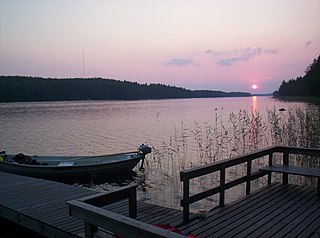
Keitele is a large lake located in Central Finland. With the area of 493.59 km2 it is the 9th largest lake in the country. The lake is divided into three regions, Ylä-, Keski-, and Ala-Keitele, of which Keski-Keitele is the largest. Water in the lake is clear and in excellent condition. The towns of Äänekoski and Viitasaari are located on the shores of Keitele.

Adolf von Becker was a Finnish genre painter and art professor of German descent. He was one of the first Finnish artists to study in Paris, who taught many of the young artists of the Golden Age of Finnish Art.

The Old Student House is the former student house of the Student Union of the University of Helsinki, located in central Helsinki, Finland, near the crossing of Aleksanterinkatu and Mannerheimintie.
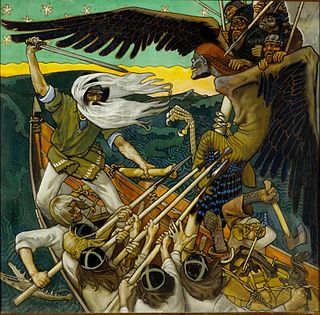
The Defense of the Sampo is a tempera-on-canvas Romantic national painting created in 1896 by Finnish painter Akseli Gallen-Kallela. The painting illustrates a passage from the Kalevala, the Finnish national epic compiled by Elias Lönnrot in the 19th century.

Hilda Flodin was a Finnish artist. She worked in a variety of media, but in the first part of her career primarily sculpture and etchings, later primarily painting, especially portraits.
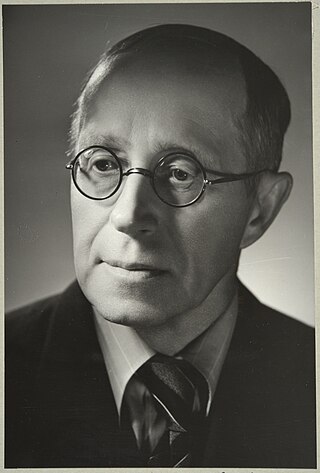
Onni Okkonen was a Finnish art historian based at the University of Helsinki.

Kullervo Sets Off for War is a painting by Akseli Gallen-Kallela from the year 1901. He painted the subject in tempera painting and as a fresco which is located in the music hall of Old Student House of Helsinki University.
David Jackson is professor of Russian and Scandinavian art histories at the University of Leeds. He is a specialist in the art of Ilya Repin on whom he wrote his PhD thesis.

Janne Sirén is a Finnish art historian and the Peggy Pierce Elfvin Director of the Buffalo AKG Art Museum, formerly known as the Albright–Knox Art Gallery in Buffalo, New York. Before joining the Buffalo AKG Art Museum, Sirén served as Director and City of Helsinki Department Chief at the Helsinki Art Museum from 2007 to 2013. Prior to that, he served as Director of the Tampere Art Museum from 2004 to 2007.

Tyrvää was a municipality in the Satakunta region, Turku and Pori Province, Finland. It was established in 1439 when the Tyrvää parish was separated from the parish of Karkku. In 1915, the market town of Vammala was separated from Tyrvää, and in 1973, Tyrvää was consolidated with Vammala. In 2009, Vammala became a part of the newly established town Sastamala.

Parisian Backyard is an oil-on-canvas painting executed in 1884 by Finnish artist Akseli Gallen-Kallela. The work is 28 × 23 cm in size and belongs to the Ateneum, part of the Finnish National Gallery in Helsinki, where it was donated in 1945.
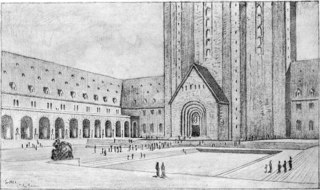
The Kalevala House was a planned huge building designed by Eliel Saarinen for the Kalevala Society in Helsinki, Finland in 1921, which was never built. It was to be built at the top of Munkkiniemi, close to the current Hotel Kalastajatorppa. The Kalevala House was to become not only the premises of the Kalevala Society, but also a center of Finnish culture: it would have included a Finnish cultural research institute, exhibition spaces, artists' workspaces and "research chambers". In addition, Finnish great men and Fennomen would have been buried in the crypt at the foot of the 80-meter-high main tower.

